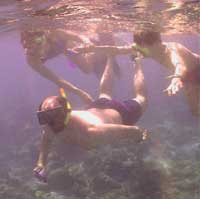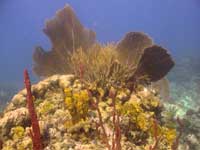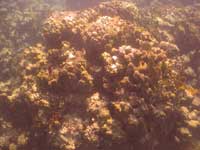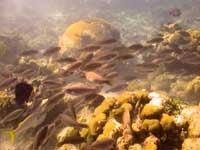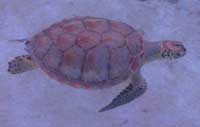 |
||||||||||||||||||||||
We had a nice lunch on Yorktown and now we are back at Peter Island. We are looking forward to getting back in the water to investigate the coral reef here. We are not looking forward to putting back on our wet suits! They are now cold and clammy after the snorkeling we did this morning! Our student explorers are joining us to explore the coral reef this afternoon, too. We enter the water and this time we swim to the other side of Great Harbor from where we explored this morning. We swim about 100 feet from the dock and we reach the start of the coral reef. The reef is from 6 feet to 20 feet underwater. Most of the corals here are large boulder corals (also called star corals) that look like large, knobby boulders. We also see some brain corals, elkhorn corals, staghorn corals and sea fans. Attached to the corals are also colorful red finger sponges and yellow tube sponges. We can see that the coral reef has been damaged. Some big boulder corals are tumbled over and broken. Like the corals we saw at Coral Gardens (Day 2), these corals were probably damaged by hurricanes. Big waves crashed into the corals knocking them over and breaking them. Fortunately, if corals are knocked over any part of the corals that is not buried in the sand will continue growing. Unlike the coral reef at Coral Gardens, this reef is mostly in shallow water. That means that these corals are more likely to be damaged by the fresh water from the hurricanes, too. The fresh water from the heavy rains from the hurricanes and the rain running off the hillsides into the harbor probably caused damage to the corals, too. We can see most of the boulder corals have white patches. These white patches are where the coral is dying. If whatever has affected the corals is gone the corals can heal and the white patches will become healthy coral again. We hope we can come back again next year and see if this reef is healing. Except for the coral damage the rest of the reef looks pretty healthy. With damage to the reef like this we would have expected to see lots of algae covering the corals because the fresh water and nutrients that run off the hillsides cause the algae to grow quickly. As we swim over the reef we think we know why the algae has not grown over and smothered the reefs. We see large schools of algae-eating fish swimming over the reef. The schools of algae-eaters include blue tangs and young parrotfish. It is about time to take our boat back to the Yorktown Clipper, so we turn around and start to head back to the dock. Our student explorer, Nathan, is out front. He has spotted something! We quickly swim over to him. It is a sea turtle, about 2 feet long! We can tell by the rounded shape of its head and the smooth edges of its shell that it is not a hawksbill sea turtle like we saw at Ginger Island (Day 6). This is a green sea turtle! Green sea turtles are not as abundant as hawksbill sea turtles, so we are glad to see one. Green sea turtles can grow to be a little larger than hawksbill turtles and weigh about twice as much. Green sea turtles can grow to be about 3 1/2 feet long and weigh over 300 pounds. Green sea turtles get their name from the green fat in their bodies. Their fat is green because of the green sea grass that they eat.
The sea turtle lets us swim along with it for a while. We notice something is sticking out of the right side of its mouth. It is a fishing hook and fishing line. We hope that the hook is not hurting the turtle because we know that the turtle will not let us swim down to him and pull it out. Well, we need to get back to the boat so we stop and watch the turtle swim away before we head back to the boat. Tomorrow we will be back in Virgin Gorda again, but this time we will take the time to investigate the most popular place to visit in the Virgin Islands. It is a maze of huge boulders called "The Baths".
Best Fishes, |
TODAY'S DATA Great Harbor, Peter Island, BVI Position: 18º 22' N / 64º 34' W Our student explorer, Nathan, explores the coral reef with his mom and dad. (Nathan's dad is holding an underwater camera.)
Among the hard corals and sea fans we see colorful red finger sponges and yellow tube sponges.
We can see that these large, knobby boulder corals are damaged. The white patches on the corals are areas where the coral is dying.
This is one of the schools of algae-eating fish we see swimming over the reef. These are young parrotfish. (Notice the white patch on the coral. In the background you can see that the edges of the brain coral are dead.)
Nathan found this green sea turtle (about 2 feet long). Enlarge the picture to see the fishing hook and line sticking out of the right side of its mouth. |
|||||||||||||||||||||
home | basecamp | archives | library | other expeditions | kids' page | contact us © 2003, The Ocean Adventure All rights reserved. |
